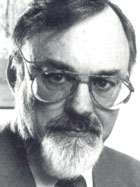2005 All England Masters International Championship - Test Piece Review
24-May-20054BR looks at the test piece - John McCabe's classic 'Cloudcatcher Fells' - a piece of technical brilliance and sublime beauty.
 John McCabe wrote his ‘Cloudcatcher Fells' for the Finals of the 1985 National Brass Band Championships of Great Britain, and since that time it has quite rightly been seen as one of the seminal works of the modern banding age.
John McCabe wrote his ‘Cloudcatcher Fells' for the Finals of the 1985 National Brass Band Championships of Great Britain, and since that time it has quite rightly been seen as one of the seminal works of the modern banding age.
McCabe was no stranger to the brass band movement prior to 1985, having written ‘Images', which was used as the set work for the 1983 Regional Championships, and which was not received with anything like the universal acclaim ‘Cloudcatcher' almost immediately received.
In fact, the composer's relationship with the movement has at times been strained to say the least. His two other works that have been used at major championships, ‘Salamander' and ‘The Maunsell Forts' have been confined to rare appearances since they were first used, due possibly to the more thoughtful nature of their musical architecture and more subtle uses of tone colours and reflection to convey the musical thought process.
All of his works though are from the very top drawer of the compositional cupboard for brass, and it says more of the movements lack of understanding and it thirst for pyrotechnic gymnastics rather than elegance and beauty that his works display that they are seen as ‘unsuitable' for the contest stage.
Even though very nearly every band lover thinks of ‘Cloudcatcher' as a classic test piece, it has also been a piece that has fallen out of favour, only to return triumphantly once more.
It is of course a very English piece of writing, although McCabe himself has been greatly influenced by the likes of Bartok and Stravinsky. The Groves Dictionary of Music describes his music as ‘vivid' ‘dynamic' and ‘dramatic' and it is easy to agree as he uses the full panoply of tone colours, dynamics and tonality to portray his thoughts.
The essence of his writing can be found in the reflective moments of his works such as the mysterious beauty of the opening and closing sections of ‘The Maunsell Forts' or the spacious sounds of the central sections of ‘Salamander'. In ‘Cloudcatcher Fells' it is the magical writing of ‘Angle Tarn' that forms the fulcrum of the work and gives the listener the opportunity to hear the innermost musical thoughts of this gifted composer. If there is anything as beautifully crafted as this in the banding world then we would love to hear it.
'Cloudcatcher Fells' takes its inspiration from the enormous natural beauty of the Lake District and also from the poem from David Wright, which gives it its title.
In his notes on the score the composer indicates that the work is associated with various Places, mostly mountainous, in the Lake District, which have particular personal significance, with an emphasis on the Patterdale area.
The work itself breaks down into four main sections: slow, quick, slow, quick. These in turn have smaller sub sections described in turn by areas of the landscape: ‘Great Gable', ‘Grasmoor' and ‘Grisedale Tarn' open the work in reflective solemn style with an initial theme motif stated by the three tenor horns. This gradually develops in more complex fashion (bar four sees the first complex multi layered entries) as if the landscape itself opens up before a walker. The dynamic levels are subdued throughout (with only the one bar of forte and the one of fortissimo) in these opening three sections.
This is then followed by the playful skittishness of the Scherzando ‘Haystacks' with the soprano voice in particular asked difficult questions and the ensemble given delicate runs of semi quavers in helping things along. This then leads into the dislocated complexities of ‘Catchedicam' which is marked Giocoso, but which has an immense of detail in the writing and ends with a splendid bit of soprano virtuosity.
The fulcrum though is ‘Angle Tarn', an extended section of the most beautiful brass writing that opens with a variant on the horn motif heard at the beginning. It is through the flowing ascending and descending carillon of lines that surround this that makes it so special; as if it reflects the various upward and downward movements of cumulus clouds as they surround the peaks of the mountains. The textures and tones that appear are sublime in nature as it ends on an upbeat note of optimism of more beauty to come.
The final section is full of drama though: echoes of the rugged landscape, scree filled slopes, razor shape outcrops of limestone and crags and precipices of resonant danger. It is very angular writing that has so much detail in the inner parts that it will take a top class band a great effort to reveal all of its hidden pleasures.
It moves with effortless pace and the use of the percussion never obliterates the central pulse that underlines the music as it heads towards its climax. The final section entitled ‘Hellvelyn' is an awesome picture of dramatic beauty which pulsates towards a huge earth shuddering ending which for good measure has a further three hammer bows just to finish things off. It is breathtaking stuff.
It rounds off an immense work and one that deserves its place as one of the classics of the banding repertoire. Enjoy it.















